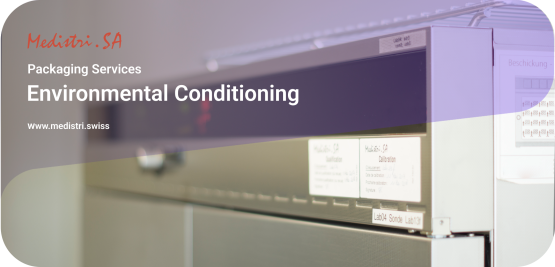(Download: Environmental Conditioning in PDF by Medistri)
Environmental Conditioning simulates particular field conditions that a package will encounter as part of the supply chain. ASTM D4332 is a standard practice for conditioning containers, packages, or packaging components for testing. Specifically, ASTM D4332 is designed for the package to experience simulated environmental conditioning before it is subjected to other testing. So, for example, the ASTM D4332 would be administered as a precursor to the ASTM D4169 test.
Environmental Conditioning testing is done to simulate the environments that products and their packaging will encounter during its distribution environment. In order to simulate said products and packages, the selected conditions for ASTM D4332 testing may be based on a historic standard or a known distribution environment.
Conducting this simulation provides objective evidence that your packaging can withstand the challenges of a worst-case climate condition from Medistri until its final destination. Most standards for environmental conditioning include subzero, tropical, and desert temperature profiles - this is to test against a worst-case climate exposure for your intended shipping environment.
One of the key benefits of environmental conditioning testing is that it allows manufacturers to identify potential weaknesses in their products before they are released to the market. For example, if a product is designed to be used in a hot and humid environment, environmental conditioning testing can help to identify any potential issues related to degradation or corrosion of the materials over time.
👉 By simulating these environmental conditions, we can more accurately represent how the product and package will withstand the shipping process as well as how future performance may be affected.
The testing process involves subjecting the test specimen to a series of environmental conditions, such as :
- High and low temperatures.
- High humidity.
- Exposure to sunlight.
👉 The specimen is then evaluated at specific intervals to determine how it has been affected by the environmental conditions.
The results of environmental conditioning testing are typically reported as changes in material properties, such as :
- Strength.
- Stiffness.
- Elongation.
👉 This information can be used to improve the design of products and to select materials that are better suited to the environmental conditions in which they will be used.
Environmental Conditioning testing is regulated under the ASTM D4332. As packages travel to labs, hospitals, customers, or other destinations, they’re exposed to a variety of environmental conditions such as temperature or humidity changes that may adversely affect the package systems.
👉 The purpose of ASTM D4332 is to simulate the environments that products and their packaging will encounter during its distribution environment. The selected conditions for ASTM D4332 testing may be based on a historic standard or a known distribution environment. By simulating these environmental conditions, we can more accurately represent how the product and package will withstand the shipping process as well as how future performance may be affected.
| Environmental Condition | Temperature (°C, °F) | Relative Humidity (%RH) |
|---|---|---|
| Extreme cold | -30 ± 2 (-22 ± 4) | Uncontrolled |
| Frozen | -18 ± 2 (0 ± 4) | Uncontrolled |
| Refrigerated | 5 ± 2 (41 ± 4) | 85 ± 5 |
| Temperature, high humidity | 20 ± 2 (68 ± 4) | 90 ± 5 |
| Tropical | 40 ± 2 (104 ± 4) | 90 ± 5 |
| Desert | 60 ± 2 (140 ± 4) | 15 ± 5 |
With environmental conditioning test results, manufacturers can accurately represent conditions that their products and packages should be able to withstand.
The following are examples of typical testing conditions that may be utilized during an ASTM D4332 test:
👉 The package should be placed and kept in a specified atmosphere for a length of time such that subsequent measurements of physical properties will be meaningful and reproducible.
👉 These conditions do not necessarily duplicate actual field conditions, but tend to simulate them and have effects on packages and materials which may be related to their field performance.
Environmental Conditioning is a critical test method that is used to evaluate the effects of the climate conditions on materials and products. It provides valuable information that can be used to improve product design and select materials that are better suited to harsh environments. By conducting environmental conditioning testing, manufacturers can ensure that their products are durable, reliable, and can withstand the challenges of the environment in which they will be used.
🎯 To learn more about Medistri’s Environmental Conditioning testing services, visit on our website at www.medistri.swiss or directly contact our team at [email protected].
- The Medistri Team
#Medistri
